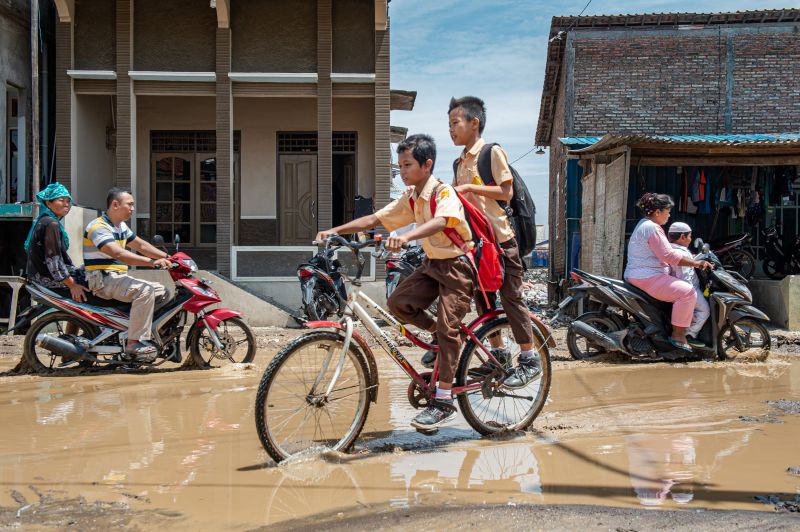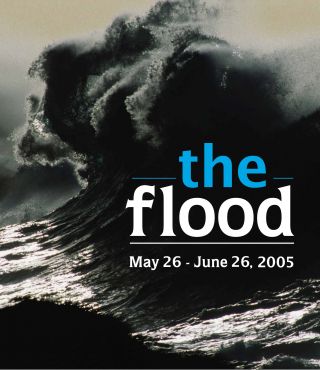Henk Ovink was appointed the first Special Envoy for Water of The Netherlands in 2015.
He was senior advisor for US Secretary Shaun Donovan of HUD in his role as Chair of the Hurricane Sandy Rebuilding Task Force. Ovink was responsible for the long term planning strategy and the widely acclaimed design competition Rebuild by Design.
Before joining the Task Force Ovink was both Director General Spatial Planning and Water affairs and Director National Spatial Planning for the Ministry of Infrastructure and the Environment in the Netherlands. As Director General he was responsible for the national policy on, the national legal frameworks for and the long term strategy, investments, programs and projects for water affairs and national spatial planning in the Netherlands.
Henk Ovink is member of the supervisory board of The Berlage Institute, the UK School of Design, Delft University of Technology Faculty of Architecture and the Master City Developer Rotterdam. He initiated the research program Design and Politics, the connecting chair Design and Politics at the TU Delft and a series of publications with 010 Publishers, called ‘Design and Politics’ covering the historical and political perspective with a focus on specific issues (designing the Randstad, Compact Cities and more). Ovink collaborates with and participates in the research program Urban Age within the Cities Program of the LSE. He lectures and publishes on the change of government, governance and planning as well as on the specific relationship between design and politics.
Water as Leverage
an agenda for collaboration

© Cynthia van Elk
Water represents man’s most challenging and complex risk. Over 80% of all climate change caused urgencies and calamities are water related.Floods and drought, pollution and water conflicts combine in conceivably disastrous ways with rapid urbanization, a growing demand for food and energy, migration, and climate change. Yet while the water challenges carry with them the risk of disruptive transitions, the omnipresence of the water challenge also offers us the opportunity to use water as leverage for truly comprehensive change by realizing transformative projects, everywhere and at every scale level.

Since the legendary ‘water biennale’ of 2005, THE FLOOD, water has been a blue thread connecting the programming and research programs of successive IABR editions. And right from that beginning, deliberately, a relationship has been established between research, presentation and implementation. In projects in the Netherlands as well as abroad, such as in and with the cities of São Paulo and Istanbul, the IABR used the water challenge as leverage for an integrated approach to sustainable urban development.
Projects
To identify and initiate such projects, in 2016 George Brugmans, the president of the IABR, and Henk Ovink, the Dutch Water Envoy, signed a Memorandum of Understanding which was extended for another four years in 2020.
IABR was instrumental in the launch of and, together with a broad international alliance of partners, is active in the World Water Atlas instigated by the Water Envoy and the Water as Leverage for Resilient Cities program that Ovink is spearheading and for which the first three projects were set up in Asia, in and with the cities of Chennai (India), Khulna (Bangladesh) and Semarang (Indonesia).
DOWN TO EARTH
The Water as Leverage agenda is the guideline for two research projects that the IABR set up in 2017, the IABR–Ateliers Drought in the Delta and Dordrecht: Water Safety as Leverage for Sustainable Urban Development, and for WATERSCHOOL M4H+.
Together with Energy Transition as Leverage, Water as Leverage is an important thread that runs through the entire DOWN TO EARTH program in 2020 and 2021.

A fine example is Water as Leverage, initiated by Ovink, together with George Brugmans (IABR), and Joachim Declerck (AWB and IABR). Its first project is Water as Leverage for Resilient Cities: Asia, which is part of the main exhibition of IABR–2018+2020–THE MISSING LINK.
location: HAKA Building
date: July 4
time: 12:30 am - 2 pm
language: English
NEXT ECONOMY! NEXT PLAN?
IABR–2016–THE NEXT ECONOMY presents us with a number of challenges when claiming that the urban economies of the future need to be inclusive, productive and circular. Cities do have ambitions, but how can these be translated into (spatial) strategies? What does cerating new narratives of the circular, healthy and productive city mean for spatial planning and design? Is the current paradigm of a decentralized and bottom up development successful, or do we need new approaches to spatial planning and governance and innovative alternative design practices?
with Henk Ovink (Special Envoy for International Water Affairs), Jeroen de Willigen (Chief Architect Municipality of Groningen, partner De Zwarte Hond), Ivonne de Nood (Manager Spatial Development Oosterwold, Almere), Steven Delva (Buiksloterham, Buiksloterham, DELVA Landscape Architects / Urbanism) and Martijn Duinveld (Wageningen University).
TUESDAY 26 APRIL
Time: 7.30 - 9 p.m.
Location: Fenixloods II, Paul Nijghkade 19, Rotterdam
Language: Dutch
Admission fee: none
A reservation in advance is highly recommendable and can be made here.
On six Tuesday evenings, RUIMTEVOLK and the IABR will highlight the issues raised by the quest for the Next Economy. How do designers, administrators, and professionals, active on the local, regional, national or international scale, tackle the issues the IABR–2016 raised: the energy transition, the healthy city, and the productive city? How can designers contribute to the reduction of the spatial separation between the disadvantaged and the winners, to a more inclusive city? How can design contribute to an urban economy that adds local value and is circular? In short, which are the concrete Next Steps for design, planning, and governance?

In Urban Landscape and Climate Change the results of the competition Rebuild by Design that responds to Hurricane Sandy, will take prominent place.
Superstorm Sandy
On October 29 2012, after a ravaging ride that started in the Caribbean and would eventually cause the death of at least 286 people in seven different countries, Superstorm Sandy slammed into New Jersey and New York with unprecedented force. The chaos that followed was just as unprecedented. The world’s most important metro region remained completely dysfunctional for days. 8.5 million people were without electricity, 650,000 houses and over 100,000 companies were damaged or destroyed. Estimates as of June 2013 assess the damage at over 68 billion US dollars.

© Billy Lyons
Hurricane Sandy was unlike any storm before it. While everyone affected by it continues to push forward with the recovery process, Sandy has made it clear that it is not possible to simply rebuild what existed before. A different approach is a necessity this time around, to make sure the region is resilient enough to rebound from future storms.
On 7 December 2012, President Obama signed an executive order creating the Hurricane Sandy Rebuilding Task Force. Secretary of Housing and Urban Development Shaun Donovan was appointed chair of the task force. One of its initiatives was Rebuild by Design. The competition aims at addressing the structural and environmental vulnerabilities that Hurricane Sandy exposed in communities throughout the region and developing fundable solutions that will better protect residents from future climate events.

© BIG Team
"How to think like the Dutch?"
Henk Ovink, who was, among other things, one of the curators of the 5th IABR: Making City, leads the competition. Its approach is new for the United States, and the fact that many Dutch design offices, engineering companies and universities are involved shows how much it is inspired by how the Dutch manage the water. Which led the New York Times to ask "how to think like the Dutch in a Post-Sandy world?"
Curator Team
Asu Aksoy (Istanbul, TR), George Brugmans (Amsterdam, NL), Joachim Declerck (Brussels, BE), Fernando de Mello Franco (São Paulo, BR), Henk Ovink (The Hague, NL) and ZUS (Rotterdam, NL)

Curator Team 5th IABR
(from left to right: Brugmans, Aksoy, Declerck, Ovink, Koreman, De Mello Franco and Van Boxel)
Director
George Brugmans
Opening
19 April 2012, by Melanie Schultz van Hagen, minister of Infrastructure and the Environment, and Ahmed Aboutaleb, mayor of Rotterdam
Exhibitions
Making City
curator: Joachim Declerck
location: NAI, Rotterdam
Smart Cities - Parallel Cases 2
curators: Stefan Bendiks, Rogier van den Berg, Matthijs de Boer, Annet Ritsema
location: NAI, Rotterdam
Test Site Rotterdam
curator: ZUS (Elma van Boxel, Kristian Koreman)
location: Rotterdam Central District
Making Douala 2007 - 2013
curators: Marilyn Douala-Bell, Didier Schaub, Xandra Nibbeling, Kamiel Verschuren, Lucas Grandin
location: RiverClub Gallery, Rotterdam
Design as Politics
curator: Wouter van Stiphout
location: Mini Mall, Hofbogen, Rotterdam
Making Almere
curator: INTI
location: Belfort 13, Almere
Making City São Paulo, Da Cidade Informal aos Novos Bairros
curator: Elisabete França
location: Museu da Casa Brasileira, São Paulo
Making City Istanbul
curators: Asu Aksoy, George Brugmans, Joachim Declerck
location: Istanbul Modern, Istanbul, main exhibition 1st Istanbul Design Biennale
April 2012 – December 2012
133.600 visitors
Events
Urban Summit
51 lectures, debates, screenings, workshops and other events
VPRO: The City Forever
a full week of television and radio programming watched and tuned into by 2,8 million people
projectmanagement: Wim Schepens
publications and documentaries
Making City, 5e IABR 2012, Catalogue
George Brugmans, Jan Willem Petersen (ed)
2012, IABR
The Future Agenda
George Brugmans, Joachim Declerck, Henk Ovink
in: Megacities, Exploring a Sustainable Future
Steef Buijs, Wendy Tan, Devisari Tunas (ed)
2010, 010 Publishers
Rotterdam - People Make the Inner City
2012, Municipality of Rotterdam
Designing Olympics
Daniël de Groot, Willemieke Hornis, Elien Wierenga (ed)
2012, 010 Publishers
Olympic Cities
XLM Architecture Research Urbanism
2012, XLM
The Netherlands in Projects
Jelte Boeijenga, Paul Gerretsen, Elien Wierenga (ed)
2013, 010 Publishers
Sürdürülebilir Kent Yapmak/Making a Sustainable City: The Arnavutköy Approach
Asu Aksoy, Gülnur Kadayifçi, Hülya Yalçin (ed)
2012, Municipality of Arnavutköy & IABR
Sürdürülebilir Kent Yapmak/Perspectives from Turkey on Sustainable City Making
Asu Aksoy, Gülnur Kadayifçi, Hülya Yalçin (ed)
2012, Municipality of Arnavutköy & IABR
900 Km Nile City: A Strategic Design for a Rural Metropolis
Pier Paolo Tamburelli, Oliver Thill (ed)
2009, The Berlage Institute Research Report No. 31
Making Douala 2007 - 2013
Xandra Nibbeling, Kamiel Verschuren (ed)
2012, Doual'Art & ICU Art Projects Foundation
The River Cities Project: IABR Catalogue
Michael Speaks, Angela Torchio (ed)
2012, University of Kentucky
Typology. Hong Kong, Rome, New York, Buenos Aires
Emanuel Christ, Christoph Gantenbein (red)
2012, ETH Zürich
Posconflicto Laboratory: Making City + Productive Housing Programm in Guatemala & Central America
Urbanistica–Taller del Espacio Publico, Municipality of Guatemala & Asociacion Centroamericana Taller de Arquitectura
2012
Making Cities
director: Alexander Oey
VPRO Tegenlicht in coproduction with IABR



